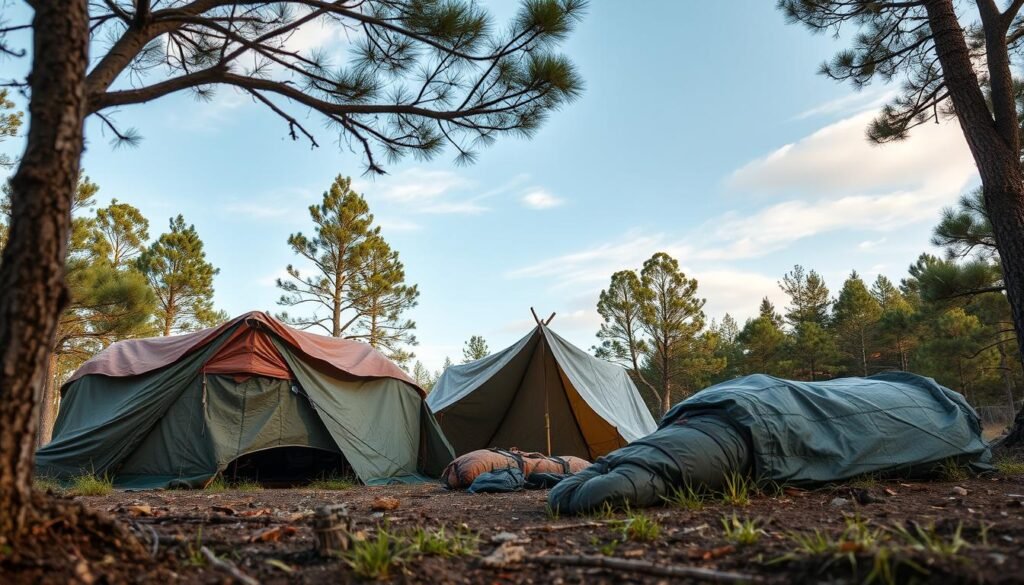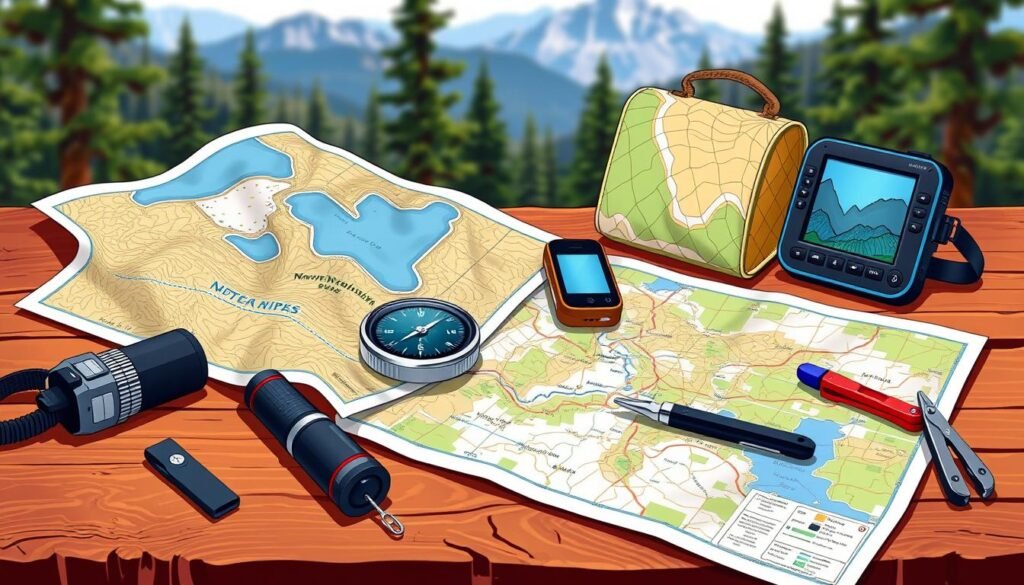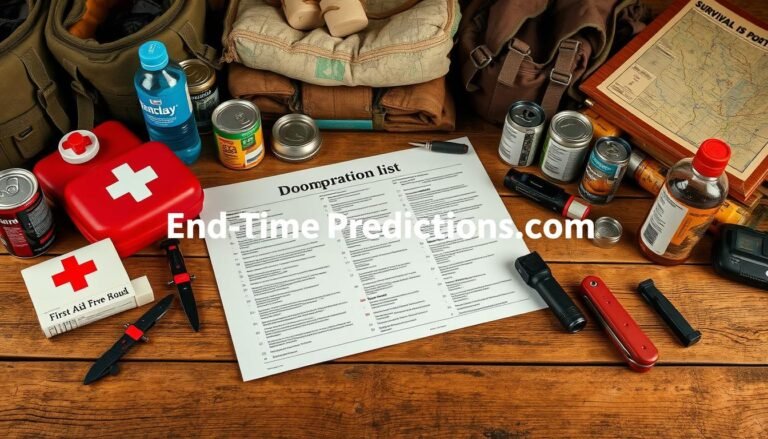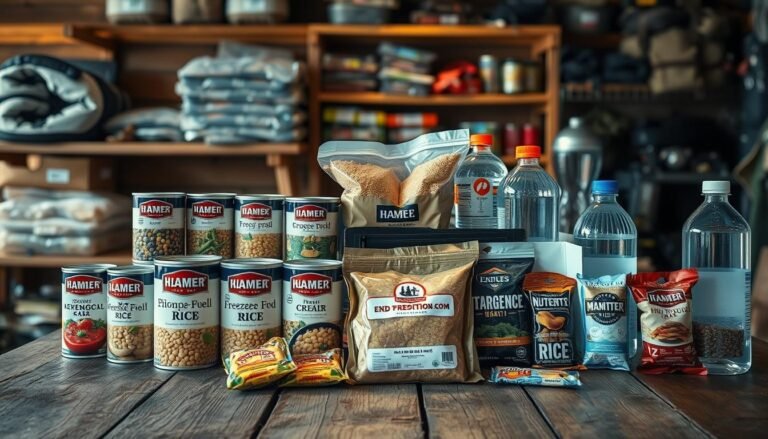Did you know a bug out bag, or “72-hour kit,” is meant to last you for at least three days in an emergency? It’s crucial because it can take up to 72 hours or more for help to arrive. Having a well-stocked prepper bag can be the difference between life and death in a crisis.
A bug out bag includes basic items like food and water for three days. It also has wilderness survival tools like clothes, rain gear, and fishing gear. Let’s explore the essential items for survival and how to put together your ultimate prepper bag.
Key Takeaways
- A prepper bag, or bug out bag, is designed to support short-term survival for at least three days.
- Basic essentials include food, water, first-aid kit, flashlight, and a hand-crank radio.
- Wilderness survival components like a multi-purpose knife and all-weather gear are crucial.
- Environment-specific items ensure preparedness based on geographic and situational needs.
- Maintaining a balanced bag weight of 25 lbs or less is recommended for ease of transport.
Understanding the Importance of a Prepper Bag
Having a prepper bag ready for emergencies is key. It’s all about being ready for disasters and not needing help. A good bag has everything you need to stay safe on your own.
A good prepper bag costs between $150 and $200. This is a smart investment for your safety. It should be light enough to carry easily, but still hold a lot.
Level 1 bags are under 20 pounds, Level 2 are under 35 pounds, and Level 3 are under 45 pounds. They come in different sizes to fit your needs.
Level 1 bags cost between $400 and $1,100. Level 2 bags cost between $800 and $2,300. Level 3 bags cost between $1,050 and $2,750. It’s a good idea to have a bag for each person over 10, and smaller bags for kids.
A good prepper bag has water treatment, warm clothes, and ways to start a fire. It also has shelter items like tarps and sleeping bags. This makes sure you’re ready for anything.
| Bag Level | Weight Limit | Capacity Requirement | Price Range |
|---|---|---|---|
| Level 1 | Under 20 lbs. | Over 25 liters | $400 – $1,100 |
| Level 2 | Under 35 lbs. | Over 44 liters | $800 – $2,300 |
| Level 3 | Under 45 lbs. | Over 49 liters | $1,050 – $2,750 |
Being prepared is more than just having supplies. It’s about planning and putting together a good bag. A well-stocked bag is a big help in keeping you and your family safe.
Choosing the Right Backpack for Your Bug Out Bag
When picking a backpack for your bug out bag, think about durability, comfort, and how much you can carry. There are many backpacks out there. It’s key to choose one that’s tough, comfy, and big enough for all your stuff.
The backpack’s durability is a big deal. Look for ones made with strong materials and good zippers, like “YKK”. These signs mean the backpack can handle tough situations. Most good backpacks cost between $125 to $300. Backpacks under $70 might not be as good.
Comfort is also super important. A good backpack should fit well and not hurt your back or shoulders. For big backpacks, a hip belt helps spread the weight. You want a backpack that’s practical but not too extreme.
How much you can carry is also key. The best backpacks for bug out bags are 40-55 liters. This size is big enough but not too big. Bags smaller than 35 liters might not have enough room. Bags bigger than 65 liters are usually too big.
Here’s a look at some popular bug out bag backpacks:
| Brand and Model | Capacity (liters) | Weight (lbs) | Key Features |
|---|---|---|---|
| Mystery Ranch Scree 32 | 32 | 2.8 | Durable, Excellent hiking/travel pack |
| Mystery Ranch Two Day Assault | 30 | 3.0 | Lacks proper hip belt |
| Blackhawk Three Day Assault | 37 | Heavy | Includes sleeping bag straps, Affordable |
| Eberlestock Switchblade F5 | 25 | 3.6 | Lacks hip belt provision for smaller waist sizes |
| Mystery Ranch Urban Assault 24 | 24 | 2.7 | Blends well in urban environment, Satisfies carry-on limit |
In short, picking the right backpack means looking at its build, size, and how comfy it is. Brands like 5.11, Osprey, and Maxpedition offer great mid-range options. Top brands like Arcteryx, Goruck, and Mystery Ranch have the best quality and design. With the right backpack, your bug out bag will be ready for anything.
Water and Hydration Supplies
Water is key in any bug out bag, meant to last for 72 hours in emergencies. Unlike food, we can only survive about three days without water. So, having enough water is vital for staying safe during disasters.
There are many Water Containers to keep you hydrated in emergencies. You can choose from hydration packs or simple canteens. They should be tough and easy to carry. About 80% of bug out bags include ways to purify water, like tablets, filters, or straws.
Water purification methods have different strengths. Tablets and drops are light but take 30-60 minutes to work. Filters, especially those with activated charcoal, purify water right away and remove more stuff. Boiling water is the best way to kill germs but you need a heat source.
Hydration packs are also important for staying hydrated on the move. They let you drink water easily without stopping. This is great for keeping your hands free for other things.
Here is a comparative breakdown of various hydration options:
| Hydration Option | Pros | Cons |
|---|---|---|
| Water Containers | Easy storage, durable | Can be bulky |
| Hydration Bladders | Convenient access, hands-free | Requires regular cleaning |
| Purification Tablets | Lightweight, essential for emergency | Time-consuming, chemical taste |
| Portable Filters | Quick purification, removes more contaminants | Can be fragile, expensive |
| Boiling | Most effective | Requires heat source, time-consuming |
Managing water in your bug out bag is crucial. It’s not just about having enough water. You also need to know how to treat and store it. Using a mix of containers, purification methods, and hydration packs will help you stay hydrated and healthy in emergencies.
Food and Nutrition Essentials
Having a prepper bag stocked with non-perishable foods is key for emergency readiness. High-protein snacks like beef jerky are great because they last long and come in many flavors. Nuts and seeds are also good because they’re light, full of nutrients, and keep you full for a long time.
Carb and calorie-rich foods like raisins give quick energy. Instant noodles and oatmeal are easy to make and don’t take up much space. For when you can’t cook, emergency food bars and canned goods are convenient and nutritious.
Protein is important for keeping muscles strong and energy up. Peanut butter, sardines, and salami or pepperoni are all good protein sources that don’t need to be refrigerated. Pouched meats like tuna and chicken are also easy to carry and versatile.
Adding nutritional supplements to your bag can help ensure you get all the vitamins and minerals you need. Caffeine and sugar are also important for staying awake and alert during emergencies.
Here are some essential non-perishable foods and their attributes:
| Food Item | Attributes |
|---|---|
| Beef Jerky | High in protein, variety of flavors, long shelf-life |
| Nuts | Nutritious, high in fiber, vitamins, and minerals, provides long-lasting fullness |
| Seeds | Lightweight, high in nutrients like sunflower seeds, chia, and flax |
| Raisins | Carb and calorie-rich for energy |
| Beans | Nutritious when cooked, need water, good portable stove food |
| Peanut Butter | Protein source, available in packets for convenience |
| Instant Noodles | Lightweight, require boiling water, provide comfort |
| Instant Oatmeal | Lightweight, easy to store, add boiled water for a quick meal |
| Dried Soup | Nutritious, easy to pack, requires boiling water for preparation |
| Sardine Tins | High protein content, convenient small tins |
| Dried Fruit | Sugary snack for quick energy replenishment |
| Salami / Pepperoni | Protein source, stable, good snack or meal addition |
| Trail Mix | Nutritious blend, provides energy and satisfies hunger |
| Military MREs | Self-contained rations, balanced calories for a day, long shelf-life |
| Emergency Food Bars | Ready-to-eat, calorie-dense, 5-year shelf life |
| Rice | Easy preparation by adding water, versatile pairing option |
| Pouched Meats | Protein sources such as tuna, salmon, chicken, easy to transport |
When putting together your prepper bag, think about what you and your group need. Include foods you like and avoid allergens. Don’t forget a small stove and durable cookware to help you prepare meals in tough times.
First Aid and Medical Supplies
Having a good emergency first aid kit is crucial for unexpected events. This section covers the key medical supplies for survival needed for disaster health care. Knowing what to include in your kit helps you handle injuries and severe medical emergencies.
A basic first aid kit is a good start, with bandages, gauze, and antibiotic ointments. But, it’s smart to add more. Include prescription medications, as they can be hard to find in emergencies.
Antibiotics are now easier to get, thanks to several companies. Adding a packet of 24 anti-diarrheal pills helps with stomach issues. Aspirin in a pack of 500 tablets is key for heart attack symptoms, but never give it to kids.
Ibuprofen, in 500 tablets of 200mg, is great for inflammation, headaches, and pains. A CAT Gen7 combat tourniquet can stop severe bleeding by clamping veins and arteries.
Sterile sutures, though tricky to use, are essential for closing wounds. A pack of 24 is highly recommended. Also, include Pocket Pepto tablets (24 ct) for stomach issues and EverLit Mylar thermal blankets (4 ct) for warmth.
For chest injuries, the Hyfin Vent chest seal pack of 2 is vital. Docusate sodium laxatives (100 tablets) help with constipation. NyQuil LiquiCaps (48 ct) relieve cold symptoms during emergencies.
Other key medical supplies for survival include 100% Aloe Vera gel for skin irritations and burns. Quick-dry towels are great for absorbing spills. Hand sanitizer and N95-style dust masks are also crucial for hygiene and protection.
Flashlights with spare batteries, candles for light and warmth, and duct tape for quick fixes are essential. A multi-tool is handy for repairs. Remember, non-perishable food and water are must-haves. Plastic ponchos are useful for sudden rain.
Understanding and preparing with these disaster health care supplies makes you ready for health emergencies. This ensures you’re prepared for any unexpected situation, which is key to thorough preparation.
Shelter and Clothing Necessities
In survival situations, having the right shelter and clothes is a must. Without them, a person can only last three hours in harsh weather. It’s vital to know how important Emergency Shelters and the right clothes are.

For bug-out scenarios, it’s best to carry compact and lightweight Emergency Shelters like tarps, bivy bags, and survival blankets. These items protect you from the weather, making them key for any prepper bag. Tarps can be set up fast for shelter, while bivy bags and blankets keep you warm.
Sleeping arrangements are also key for surviving in different places. You need lightweight and compact sleeping bags for various climates. Thermal sleeping pads or foam mats also help keep you warm by insulating you from the cold ground. This survival gear keeps your body temperature stable and makes sleeping more comfortable in tough conditions.
Clothing is your first defense against the weather. For different climates, choose all-weather clothes. This includes moisture-wicking shirts, thermals, rain jackets, cargo pants, and sturdy hiking boots. Wearing layers lets you adjust to changing temperatures and weather. A heavy-duty belt and a durable hat also offer extra protection and usefulness.
Choosing the right shelter and clothes wisely prepares you for emergencies. Having an Emergency Shelter and the right clothes can greatly improve your survival and comfort chances.
| Essential Gear | Description | Purpose |
|---|---|---|
| Tarps | Lightweight, waterproof material | Quick setup shelter |
| Survival Blankets | Compact, thermal efficient | Body heat retention |
| Moisture-Wicking Shirts | Breathable, quick-dry fabric | Comfort in various temperatures |
| Rain Jackets | Waterproof, windproof | Protection from rain and wind |
| Thermal Sleeping Pads | Insulated ground padding | Ground insulation and comfort |
Fire Starting Tools
In emergency situations, starting and keeping a fire is key for warmth, cooking, and safety. Learning different ways to start a fire can help you be ready for anything.
Many fire starter kits are great because they work well even when it’s wet and windy. Mixing old and new ways to start a fire can really help you succeed in the wild.
- Ferro Rods: These tools make sparks at very high temperatures, lighting tinder fast.
- Magnifying Lenses: Often not thought of, they can focus sunlight to start a fire without modern tools.
- Bic Lighters: Easy to carry and use, Bic lighters are good for quick fires but need care.
Keeping a fire going in emergencies depends on being prepared and using good fire starting methods. Here’s a look at some popular tools for starting fires:
| Fire Starting Tool | Advantages | Disadvantages |
|---|---|---|
| Ferro Rod | Very reliable, works in wet conditions | Needs practice to use well |
| Glass Magnifying Lens | No need for modern stuff, lasts a long time | Needs sunlight, not good at night |
| Bic Lighter | Quick and simple to use, light | Has limited fuel, wind can affect it |
Having different fire starter kits means you can handle many situations. This makes keeping a fire going in emergencies easier.
Navigation and Communication Devices
In any emergency, having good navigation and communication tools is key. They help you stay safe and keep in touch with others. Make sure your prepper bag has both old and new tools like maps, compasses, and two-way radios.

- Maps: Always carry updated physical maps of your area and any places you might visit. They’re crucial when GPS fails.
- Compass: A good compass, like the Brunton TruArc 3, is vital for finding your way in the wilderness. It costs about $17.
- Two-Way Radios: These are key for staying in touch with your group or calling for help. They’re very useful when phones don’t work.
- Signal Mirror: For signaling help from far away, a signal mirror is essential. It costs between $8 and $30.
- Emergency Whistle: A whistle like the UST JetScream is vital for getting noticed in survival situations. It costs about $9.
Also, think about adding a few extra items to your survival kit:
- Electric Solar Charger: It’s great for charging devices when you’re not near power.
- Cell Phone: It’s essential for staying in touch. Make sure it’s fully charged and ready.
- Emergency Signal Vests: They help rescuers find you, especially in thick woods or at night.
A complete emergency kit costs about $65. You can save money by not getting things like the Fischer Space Pen. Items like All-Weather Notebooks cost between $4 and $14. The Fischer Space Pen is $10 to $30.
Having these emergency navigation tools makes you better prepared for unexpected situations. They help you stay on track and keep in touch with others.
Tools and Multi-purpose Items
Having multipurpose tools in your bug out bag is key for survival. These tools can do the job of many single items, making your bag lighter and less cluttered. Items like knives, ropes, and other essentials are crucial. They make your survival kit more effective.
A high-quality survival knife is a must-have. It’s great for cutting, carving, and even defending yourself. Adding a sharpening tool keeps your knife sharp. The SEVENTY2 Survival Backpack from Uncharted Supply Co. comes with these essential items.
Paracord and rope are very versatile in survival situations. They help build shelters and catch food. Since we can survive weeks without food but only three days without water, having the right tools is crucial.
Here is a comparative overview of essential Multipurpose Tools:
| Tool | Primary Function | Additional Uses |
|---|---|---|
| Survival Hatchet | Chopping | Pry Tool, Shovel, Wrench |
| Survival Whistle | Signaling | Compass, Dry Container, Flint |
| Multitool | Basic Tools | Straight Blade, Saw, Can Opener |
| Tarp | Shelter | Signaling, Makeshift Stretcher |
| Plastic Bags | Carrying Water | Keeping Gear Dry, Storing Food, Organizing Items |
Choosing simple, multipurpose items like duct tape and sanitary pads is smart. Duct tape can fix things and stop bleeding. Sanitary pads can start fires. Remember, your brain is the most important tool for survival. It helps you solve problems and adapt quickly.
Personal Hygiene and Sanitation
In crisis situations, keeping clean is key to avoid getting sick. Your emergency kit should have all the basics for staying clean. Let’s look at the must-haves for your survival kit.
Start with hand sanitizer that has at least 60% alcohol. It’s great for killing germs. Also, bar soap and water are the best for washing hands and body. Choose biodegradable options to protect the environment.
- Bar of Soap: Essential for body hygiene, washing clothes, and dishes. Consider natural options like GRENADE SOAP CO. MAVERIX SOAP, a high-quality choice made in the USA.
- Hand Sanitizer: Must contain at least 60% alcohol for effective germ-killing.
- Toothbrush and Toothpaste: Critical for oral hygiene, preventing infections.
- Wet Wipes: Versatile, perfect for cleaning hands and body and refreshing during long treks. EPIC WIPES are a practical option.
- Biodegradable Shampoo: Helps maintain hygiene by washing the head.
For managing liquid waste in emergencies, use commercial sanitation bags. Feminine products can also be used for hygiene and as tinder for fires.
“A well-maintained hygiene kit is not just about staying clean; it’s about sustaining health and preventing disease in survival situations.”
Include personal grooming tools like a comb, nail clippers, and a camp mirror. These items help keep morale up. Travel-sized hygiene and sanitation supplies are great for emergency kits because they save space.
| Item | Purpose |
|---|---|
| Toilet Tissue | Personal hygiene and potential fire starter |
| Comb | Maintaining hair cleanliness and morale |
| Sanitation Bags | Managing waste effectively |
| Diapers | Essential for baby kits, at least five days’ worth |
| Lip Balm | Protecting lips from sun and wind damage |
Being ready with sanitation supplies is crucial for staying healthy in emergencies. It’s a key part of being prepared.
Maintaining and Updating Your Prepper Bag List
Keeping your survival kits up to date is key for anyone serious about being prepared. It’s important to regularly check your prepper bag to make sure everything works and is still useful. As the world changes, so should your bug out bag’s contents.
Start by replacing expired items like food, water purification tablets, and medical supplies. These are crucial for staying alive and healthy. Old supplies can be dangerous. Also, check that your tools, fire-starting gear, and communication devices are in good shape.
Items like respirators or gas masks are especially important due to rising threats. Make sure they’re ready for use. Models like the CM-8M or Tactical Air-Purifying Respirator (TAPR) need regular checks.
Don’t forget to keep up with new technology and products. Modern tools like the Geiger-2 can detect radiation better than older ones. Consider replacing single-use items with multi-purpose ones to save space and weight.
Look for backpacks that are organized and comfortable. Tactical backpacks like the 5.11 Rush 72 Backpack are great for organization. Hiking backpacks, such as the Gregory Baltoro 65, are better for carrying weight and keeping you cool.
FAQ
What are the most essential items to include in a prepper bag?
A prepper bag should have food, water, and a first aid kit. Also, include shelter, clothing, and tools for starting fires. Don’t forget navigation devices, hygiene supplies, and multipurpose tools. These items are key for disaster preparedness.
Why is having a well-stocked prepper bag important?
A well-stocked prepper bag helps you survive on your own during emergencies. It keeps you safe by providing food, water, and medical supplies. This is crucial for personal and family safety.
What features should I look for in a reliable bug out bag?
Look for durability, ergonomic design, and enough space for all your supplies. Choose a bag that fits your needs, whether tactical or civilian style. It should be ready for any situation.
What are the best water purification methods for a survival situation?
Use water filters, purification tablets, and portable purifiers to clean water. Also, carry hydration packs and sturdy containers for storing water. These ensure you have clean water in emergencies.
What kind of food should I pack in my prepper bag?
Pack non-perishable foods like canned goods and dehydrated meals. Include energy bars and emergency cooking supplies. Nutritional supplements help keep you energized and healthy during stressful times.
What medical supplies are crucial for a first aid kit in a prepper bag?
Your first aid kit should have bandages, antiseptics, and pain relievers. Don’t forget personal medications. Also, include sutures, splints, and emergency blankets for more serious injuries.
How should I prepare for diverse weather conditions?
Include emergency shelters, all-weather clothing, and survival sleeping gear. These items keep you warm and comfortable in any weather. They’re essential for surviving in different climates.
What fire starting tools should I have in my survival kit?
Carry waterproof matches, lighters, and fire starter kits. Magnesium fire starters are also useful. These tools help you start fires for warmth, cooking, and protection, even in bad weather.
What navigation and communication devices are important during an emergency?
Maps, compasses, and two-way radios are crucial. They help you travel safely and stay in touch with others. These devices are vital when modern tech fails.
What multipurpose items should be included in a prepper bag?
Include survival knives, durable ropes, and versatile gear. These items are useful for building, repairing, and navigating. They’re essential for their many uses in emergencies.
How can I maintain hygiene and sanitation in a survival situation?
Pack biodegradable soaps, sanitizers, and waste disposal options. Follow Leave No Trace principles to keep clean and prevent illness. This is important for your health and the environment.
How often should I review and update my prepper bag contents?
Check and update your prepper bag regularly. Replace expired or used supplies to stay ready for any crisis. This ensures your bag is always prepared for emergencies.
Source Links
- https://mountainhouse.com/blogs/emergency-prep-survival/bug-out-bag?srsltid=AfmBOorZoOWwCjcRpnGDZnElBu0eBsBiIIEXEVKV_0tYwebcc9in_NO4
- https://www.offgridweb.com/gear/bug-out-bag-list-essentials/
- https://www.bugoutbagbuilder.com/learning-tutorials/bug-out-bag
- https://theprepared.com/bug-out-bags/guides/bug-out-bag-list/
- https://survivalskills.guide/bug-out-bag-list/
- https://theprepared.com/bug-out-bags/reviews/best-bug-out-bag-backpack/
- https://theprepared.com/forum/thread/best-bug-out-bag-backpack/
- https://unchartedsupplyco.com/blogs/news/bug-out-bag-checklist?srsltid=AfmBOorsRMWXTwgbuimD0dOQ1yAOPf3MbISaO4XhXvIRwz70rHQzcBxQ
- https://mountainhouse.com/blogs/emergency-prep-survival/bug-out-bag?srsltid=AfmBOordIjMpk2jbqxbyf58oFZWFeblUqh74Ti6IkIBK8tg5WgrIqUb-
- https://www.thebugoutbagguide.com/bug-out-bag-list/
- https://peopleschoicebeefjerky.com/blogs/news/bug-out-bag-food-list?srsltid=AfmBOooU7j-pBDqaP5TtYJh8eTB-0AD3pB4pfLtnqz14ixQR0Y8xMn0q
- https://unchartedsupplyco.com/blogs/news/bug-out-bag-checklist?srsltid=AfmBOop9L6ANntOjwaWr1bvqmBhj-mTwMym7gfYqKxe6N-SExWsEvOq2
- https://premierbodyarmor.com/blogs/pba/best-bug-out-bag-food?srsltid=AfmBOooUZX6RdFf4of4Q3D4zKybtdkrC1odd0NDxkmdHhlxF10gVOm6W
- https://trueprepper.com/kits/first-aid-kit/
- https://judy.co/blogs/content/bug-out-bag-checklist
- https://unchartedsupplyco.com/blogs/news/bug-out-bag-checklist?srsltid=AfmBOoqvQu0XXN5JLjBNsGSo4CLGm5yn_KsGd4fum8jGL2pb_21c4QzC
- https://trueprepper.com/kits/bug-out-bag-list/
- https://thesurvivaluniversity.com/survival-tips/wilderness-survival-tips/bug-out-bag/
- https://survivalskills.guide/long-term-wilderness-survival-gear/
- https://www.ready.gov/kit
- https://www.bugoutbagbuilder.com/blog/emergency-communication-navigation-tool-kit
- https://strykerradios.com/survival/bug-out-bag-essentials-every-survivalist-needs/
- https://www.jackery.com/blogs/knowledge/bug-out-bag-list?srsltid=AfmBOooq6qoiHuKWVZcWC1H5pdorK6dU7Nt2W28LyzmrpZv8Xon9uOK9
- https://unchartedsupplyco.com/blogs/news/bug-out-bag-checklist?srsltid=AfmBOooqkqsPrUDZ5icsNbWDU4fXKPhQoPFIdRWWcmeLyVzyylmE8FGv
- https://www.thebugoutbagguide.com/multi-purpose-survival-tools/
- https://beready.utah.gov/family-preparedness/12-areas-of-preparedness/hygiene-sanitation/sanitation-in-kits/
- https://premierbodyarmor.com/blogs/pba/bug-out-bag-checklist?srsltid=AfmBOoqb_PMQMTdZpPgAxWIuKHJVE-kNW-JjYIiEO50NekNHUl-fOfuk
- https://www.battlbox.com/blogs/battlbox/everything-you-should-include-in-your-survival-hygiene-kit?srsltid=AfmBOoo2M8I9E8ITDQKfBH3Efkr2L-GLvWXxXlFVgZPIigmFCK6iCgs3
- https://readytogosurvival.com/blogs/tactical-skills/ultimate-bug-out-bag-list
- https://www.mirasafety.com/blogs/news/2024-bug-out-bag-gear-guide?srsltid=AfmBOoqb50U9BQJeWTEwhfUEgPU6hLN9MK8xC_FBmzv5Y8LolaY-6bO9




